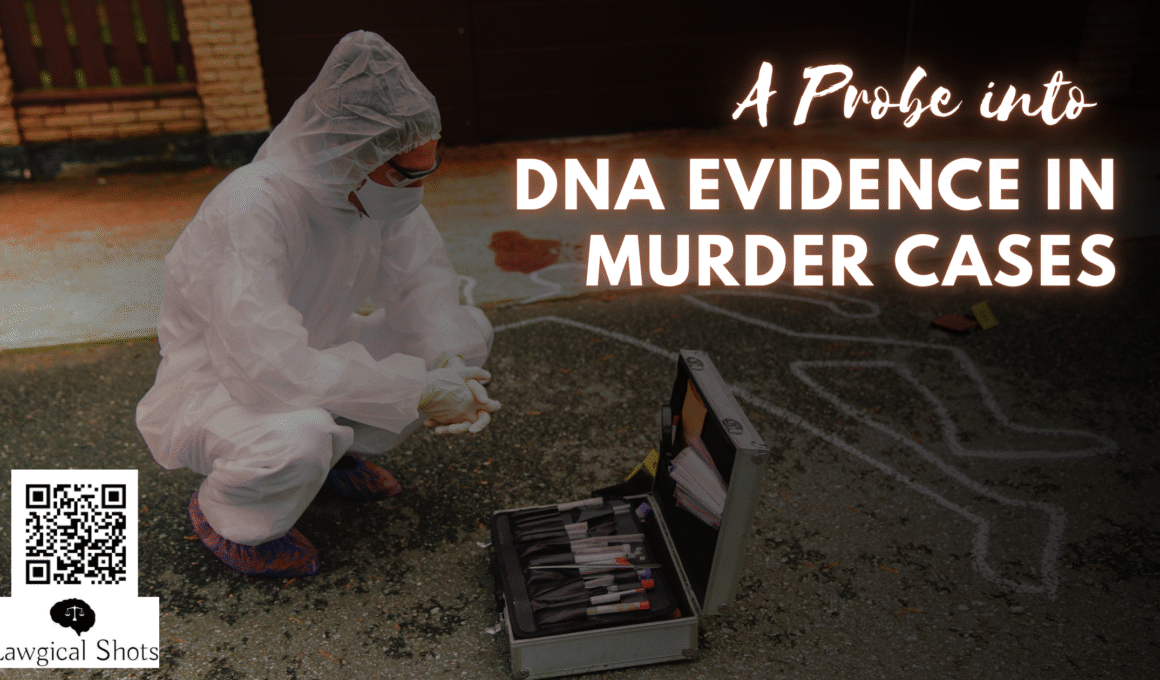“Whenever two objects come into contact, they always leave a trace on the other.”
~Locard’s Exchange Principle
Locard’s Principle of Exchange signifies that every criminal can be connected to the crime by contact traces carried from or left at the crime scene. This is where DNA evidence in murder cases holds its ground. Killing someone is not something which can be done effortlessly in the blink of an eye. The struggle, the secrecy, and the planning often leads the investigating agency towards the suspect. For those interested in criminal investigation, trials, and legal practice need to grasp the basics of forensics as well as applicable laws. Murder cases and DNA evidence are in focus here, taking one step further, more firm and research worthy.
What is DNA Evidence?
DNA is a scientific term which stands for Deoxyribonucleic Acid. It is a set of information present in the cells of an organism, including humans. DNA carries unique information about the bodies and genetics of a person. Every individual has a distinct DNA, which helps identify one against another. The chances of two people having exactly the same DNA profile is 30,000 million to 1 (except for identical twins). That is why DNA evidence is sought to be the most precise to be admissible expert evidence.
Types of DNA Evidence at Crime Scene
- Blood Samples
- Semen
- Hair
- Saliva
- Faecal Material
- Urine
- Bone
- Teeth
- Nail Scrapings
DNA Evidence in Murder Cases
When a person kills another, the offence is not always committed in public and not usually admitted of guilt. Most of the times, a person is murdered in private, and there are suspects based on evidence available. Even if a murder takes place in the presence of one or more eyewitnesses, the accused persons do not usually plead guilty. This requires the Prosecution to prove their version of accusations based on available evidence.
In most of the murder cases, there is use of weapons, and there is violence, while one tries to kill another, and the other side attempts to avoid the attack. During this tussle, DNA of the killer may be available at the crime scene. It could be hair strands which fall, there could be saliva on bite marks on the victim, there could be semen samples in case of sexual assault, etc. All these DNA samples are evidence for the Prosecution. DNA evidence in murder cases are carefully collected, sent for profiling in Forensic Science Laboratory (FSL). The samples are matched with that of the victim (for elimination) and matched with the suspect.
DNA evidence in murder cases also helps with identification of the victim in cases where the deceased person is defaced. The DNA samples are matched with the parents or siblings of the suspected victim. The Tandoor Murder case is the best example for use of DNA evidence in murder case to identify the victim. Other significant examples are Priyadarshini Matoo case, Nirbhaya case, Sheena Bora murder case, etc.
How is DNA evidence used in murder cases?
Types of evidence in the form of DNA samples prove to be a crucial tool for criminal cases, for both Prosecution and Defense. DNA evidence in murder cases is paramount for the Prosecution to identify the accused person and prove his/her guilt. On the other hand, it is equally important for the defense counsel to disprove the version of Prosecution.
If the DNA theory suggested matches as per the results, it may implicate the suspect. If the DNA does not match as purported, it may result in exoneration. DNA evidence in murder cases may also play as circumstantial evidence if it supports other evidence like fingerprints, witness testimony, etc. Forensic experts testify the probability of sample DNA belonging to anyone other than the purported – victim of accused. They may also confirm or testify the methods and safeguards to avoid contamination of DNA evidence in murder cases.
Chain of Custody for DNA Evidence
The DNA from crime scene should be collected by the investigating authorities with utmost care to avoid contamination or destruction. That is why the general timeline for collection of forensic evidence is within 12-24 hours or a maximum of 72 hours. The samples collected are securely sent to the FSL. Lab diagnosis/tests are done carefully without any error or contamination and results are shared with the investigating agency. The chain of custody of DNA evidence in murder cases should be intact. Otherwise, any break in the chain allows the opposing counsel (Defense or Prosecution) to challenge the authenticity and reliability of such FSL test reports. Proper docketing, documentation, etc. has to be done for DNA evidence to be admissible in the Court of Law. Every person involved in handling murder case DNA evidence becomes a witness for the part played by them during DNA profiling.
Murder, DNA Evidence and Challenges
- Contamination or mishandling can compromise the FSL results. It can happen at any point – evidence collection, preservation, or analysis process.
- Mixed, partial or degraded DNA may yield inconclusive or erroneous profiles.
- Transfer DNA (contacted from an innocent person) can complicate the interpretation.
- The murder case DNA evidence must be considered alongside the context. A DNA match only shows presence, not intent, and definitely not the guilt.
Inference
So far, it can be seen that DNA evidence in murder cases can be a significant breakthrough during trials. However, things are not as they seem, for everything looks good in theory. Reality strikes when practical challenges hit the roads.
Let’s recall what happened in the Sessions Court during a criminal trial. A policeman entered the Courtroom with a dusty cloth bag (definitely not sealed but kept in a reckless knot). Then he pulled out what seemed a men’s shirt – off-white in colour with some part of it containing rusty, reddish-brown spots. The shirt was soaked in blood during the crime for which trial was taking place. The FSL report for the blood stains only confirmed that it was human blood.
Getting back to the Advocate’s chamber, when the question was put by the junior why there was no discussion over whether the blood was that of victim woman or the male suspect, or their blood groups, or DNA, the answer was very practical. There are not many Forensic Science Laboratories, and the existing ones are burdened with workload. The samples shared for simple testing already take ages, and tests like DNA profiling will take ages. Another facet is the lack of training of Police officials who investigate the crime scenes, who often slip off through DNA evidence.
That is why DNA evidence in murder cases are not very commonly heard of in Criminal trials. They are mostly confined to high profile cases which shake the nation, hit the headlines, and are probably investigated by other agencies like the Central Bureau of Investigation (CBI), Criminal Investigation Department (CID), National Investigation Agency (NIA), etc.








